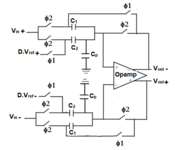Chinmaye
Full Member level 3
I have designed a flip-around fully differential switched-capacitor multiply-by-2 amplifier. I have seen a few IEEE journals that calibrate the offset voltage of the op-amp. But, I feel the offset voltage is taken care of by the differential structure. I don't understand the need to calibrate the offset voltage of the op-amp. Could someone explain this?
